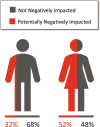Gender bias in teaching evaluations: the causal role of department gender composition
- PMID: 36649402
- PMCID: PMC9942858
- DOI: 10.1073/pnas.2118466120
Gender bias in teaching evaluations: the causal role of department gender composition
Abstract
Women are underrepresented in academia's higher ranks. Promotion oftentimes requires positive student-provided course evaluations. At a U.S. university, both an archival and an experimental investigation uncovered gender discrimination that affected both men and women. A department's gender composition and the course levels being taught interacted to predict biases in evaluations. However, women were disproportionately impacted because women were more often in the gender minority. A subsequent audit of the university's promotion guidelines suggested a disproportionate impact on women's career trajectories. Our framework was guided by role congruity theory, which poses that workplace positions are gendered by the ratios of men and women who fill them. We hypothesized that students would expect educators in a department's gender majority to fill more so essential positions of teaching upper-level courses and those in the minority to fill more so supportive positions of teaching lower-level courses. Consistent with role congruity theory when an educator's gender violated expected gendered roles, we generally found discrimination in the form of lower evaluation scores. A follow-up experiment demonstrated that it was possible to change students' expectations about which gender would teach their courses. When we assigned students randomly to picture themselves as students in a male-dominated, female-dominated, or gender-parity department, we shifted their expectations of whether men or women would teach upper- and lower-level courses. Violating students' expectations created negative biases in teaching evaluations. This provided a causal link between department gender composition and discrimination. The importance of gender representation and ameliorating strategies are discussed.
Keywords: gender bias; teaching evaluations; university policy.
Conflict of interest statement
The authors declare no competing interest.
Figures





References
-
- Colby G., Fowler C., Data Snapshot: IPEDS Data on Full Time Women Faculty and Faculty of Color (2020). American Association of University Professors.
-
- Wagner N., Rieger M., Voorvelt K., Gender, ethnicity and teaching evaluations: Evidence from mixed teaching teams. Econ. Educ. Rev. 54, 79–94 (2016).
-
- Boring A., Gender biases in student evaluations of teaching. J. Public Econ. 145, 27–41 (2017).
-
- Rosen A. S., Correlations, trends and potential biases among publicly accessible web-based student evaluations of teaching: A large-scale study of RateMyProfessors.com data. Assess. Eval. High. Educ. 43, 31–44 (2017).
-
- Wang G., Williamson A., Course evaluation scores: Valid measures for teaching effectiveness or rewards for lenient grading? Teach. High. Educ. 27, 1–22 (2020).
MeSH terms
LinkOut - more resources
Full Text Sources

